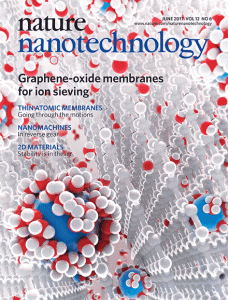Nature Nanotechnology, 2017, 12(6), 546-550
Jijo Abraham, Kalangi S. Vasu, Christopher D. Williams, Kalon Gopinadhan, Yang Su, Christie T. Cherian, James Dix, Eric Prestat, Sarah J. Haigh, Irina V. Grigorieva, Paola Carbone, Andre K. Geim & Rahul R. Nair
Graphene oxide membranes show exceptional molecular permeation properties, with promise for many applications. However, their use in ion sieving and desalination technologies is limited by a permeation cutoff of ∼9 Å (ref. 4), which is larger than the diameters of hydrated ions of common salts. The cutoff is determined by the interlayer spacing (d) of ∼13.5 Å, typical for graphene oxide laminates that swell in water. Achieving smaller d for the laminates immersed in water has proved to be a challenge. Here, we describe how to control d by physical confinement and achieve accurate and tunable ion sieving. Membranes with d from ∼9.8 Å to 6.4 Å are demonstrated, providing a sieve size smaller than the diameters of hydrated ions. In this regime, ion permeation is found to be thermally activated with energy barriers of ∼10-100 kJ mol-1 depending on d. Importantly, permeation rates decrease exponentially with decreasing sieve size but water transport is weakly affected (by a factor of <2). The latter is attributed to a low barrier for the entry of water molecules and large slip lengths inside graphene capillaries. Building on these findings, we demonstrate a simple scalable method to obtain graphene-based membranes with limited swelling, which exhibit 97% rejection for NaCl.

